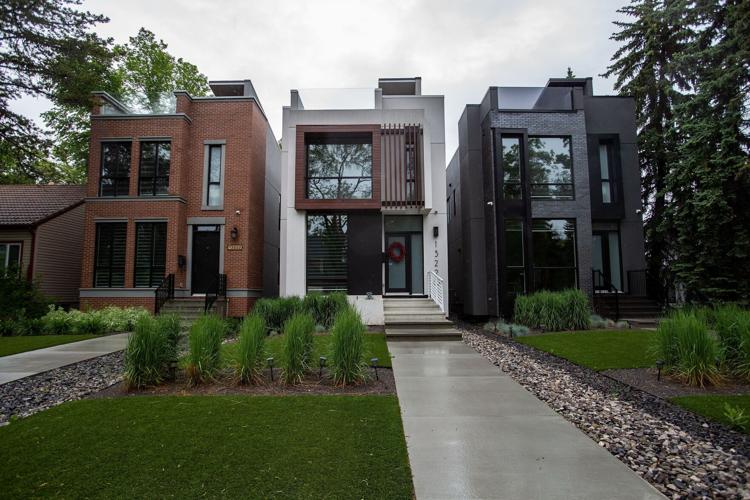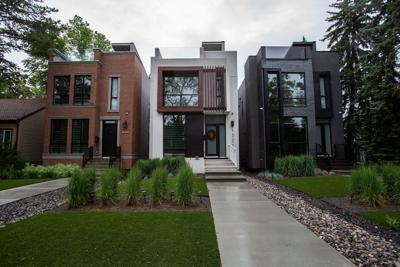In the beginning, everyone hated “the skinnies.”
They didn’t like the designs, Edmonton city councillorÌýMichael Janz remembers.
But then they started popping up.
“It moves from ‘that skinny’ to somebody’s home, and you think more of the neighbour than the home,” Janz said.
Over a decade ago, Edmonton started allowing wide lots to be split in certain areas in order to build two narrow homes, with the cheeky nickname “skinnies.”
Then, in late 2023, council allowed up to eight units and three storeys built on lots as of right, meaning without having to go to city council or committees for special permissions. That led to a flurry of building activity in mature neighbourhoods.
Across Canada, according to a recent report from the Edmonton is the only major city on track to build enough housing to get back to pre-pandemic levels of affordability.ÌýIn comparison, ÎÚÑ»´«Ã½ is about 32,000 homes a year short.Ìý
“Edmonton has been on a journey over the last 20 years. We’ve allowed duplexes, triplexes, lot splitting and all the way up to eightplexes” Janz said.
As ÎÚÑ»´«Ã½ continues to try to find solutions to the housing crisis, with a proposal to allow sixplexes in neighbourhoods citywide goingÌýto council Wednesday, Edmonton can offer some lessons learned — from the importance of flexibility to the benefits of getting shovels in the ground as soon as possible.Ìý
From theory to practice
In Janz’s experience, once people see more kids going to local schools, pools and libraries, and small businesses opening to serve new people, longtimeÌýresidents come around to the idea of more density.
“The sooner you can move from the conceptual and theoretical to the personal, is so critical,” he said.Ìý
Like with the skinnies, the renters or owners become their neighbours, instead of an outside threat.Ìý
“The fear of the unknown is always there, and that’s a big factor, for sure. But often what we find is once the infill goes in, it goes from being an infill to Michael’s house.”
With zoning relaxed to allow up to eight units, there wereÌý16,519 new housing units approved in 2024, according toÌýÌýa 30 per cent increase from 2023.
There was also a 41-per-cent increase in permits received in 2024 compared to 2023.
, said the city has been on a similar journey to ÎÚÑ»´«Ã½ “except happening earlier and faster.”
But like in ÎÚÑ»´«Ã½, Edmonton is also getting some pushback from homeowners.
Edmonton city council will debate a motion to limit midblock lots to six units — keeping up to eight on corners — as well as some design adjustments, on June 30.
NeighboursÌýÌýabout loss of privacy and trees, potential damage to their foundations from construction, and noise and garbage.
Dawang said the reality is a lot of the new projects are “still holes in the ground” and so it makes sense that council is hearing from neighbours who are upset about that, rather from residents who are living in these places. But hopefully, with time, this will change.
Affordability as more than just priceÌý
In Edmonton, like in ÎÚÑ»´«Ã½, multiplex units can be either owned or rented.
One common criticism,ÌýJanz said, is that the prices are too high.

“Fundamentally it is about offering more housing choices in more places where people want to live,” said Edmonton city councillor Michael Janz. “We do not want the affordability problems that ÎÚÑ»´«Ã½ has.”
SuppliedThis is something that’s also been said about ÎÚÑ»´«Ã½’s multiplexes, whereÌýa recent walk-up project at Gerrard and Main streets had units listed at around $1 million each.Ìý
Although Edmonton’s unaffordable is not quite ÎÚÑ»´«Ã½’s unaffordable (the average detached home costÌýinÌýÌýwasÌý$579,704Ìýlast month vs.Ìý$1.7 million in ,ÌýJanz said it’s important to keep in mind thatÌýaffordability is more than just rent or purchase price.Ìý
If you don’t need a car to get to school or work, or can go from a two-car to one-car family, there’s a big savings there as well as a positiveÌýenvironmental impact.Ìý
Politicians and city staff buy-in
Dawang, who previouslyÌýlived in ÎÚÑ»´«Ã½, said there’s more recognition from both the left, the right and city staff that more housing supply is needed in Edmonton.
“They understand the consequences of not building more density,” he said.
He’s not totally sure why, but the fact that Edmonton councillors at the moment are fairly young might have something do with it.
Flexibility
Janz hopes the proposed move from eight to six units midblock, where lots are typically smaller, can help ease some of the local pushback.
Dawang is more skeptical of this change, and believes it’s more “vibe based” to appease neighbours’ concerns.
But still, he says that the zoning bylaw overhaul has achieved its goals.
“Fundamentally it is about offering more housing choices in more places where people want to live,” added Janz, noting Edmonton’s population has swelled over the last three years, adding about 140,000 people by the city’s count.
“We do not want the affordability problems that ÎÚÑ»´«Ã½ has.”
































To join the conversation set a first and last name in your user profile.
Sign in or register for free to join the Conversation